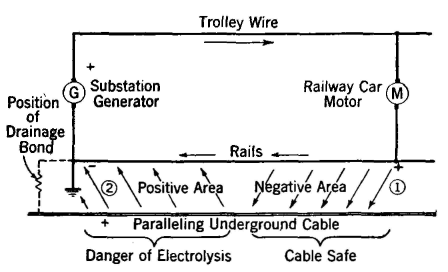| Electrical Communication is a free textbook on the basics of communication technology. See the editorial for more information.... |

|

Home  Interference and Noise Interference and Noise  Electrolysis Electrolysis |
|||






|
|||
ElectrolysisTelephone cable sheaths that are made of lead and antimony and that are buried underground offer very low-resistance paths to stray currents flowing through the earth. Where the current enters the cable (according to the conventional direction) no harm is ordinarily done; but where it leaves the cable (unless a solid contact is made) electrolytic action takes place, and, if this action is long continued, the sheath may be entirely eaten through. This permits the entrance of moisture, thus damaging the cable and interfering with service. Although electric trolley networks and direct-current power systems in general are not being extended at present and in many instances are being abandoned, the problem of preventing electrolysis is in some respects even more important than in past years. One reason for this is that telephone cables are being placed underground at an increasing rate, and another is that many of these underground cables provide very important toll service. In considering electrolysis it is convenient to use a street railway system as an illustration. The trolley is positive, and the earth and rails are negative, the potential difference usually being about 600 volts. According to the conventional direction, the current flows out on the trolley wire and back to the substation through the rails. Heavy conductors called negative feeders are often installed in parallel with the rails to act as an additional return path. Rail joints are bonded together with low-resistance conductors to keep the rail return resistance low. If the rails are small, if the rail bonds are in poor condition, or if the negative feeder system is inadequate, the return path for the current will be of high resistance, and there will be a tendency for the currents to leave the rails and flow in the earth and in underground pipes and cable sheaths to the vicinity of the substation or negative feeder taps. At these points the currents leave the underground structures, and it is at these discharge points that damage is done. The decomposition of the sheath follows the laws of electrolytic action, the rapidity of the action varying with the magnitude of the current and the length of time it flows. The sketch of a street railway system shown in Fig. 25 indicates the tendency of currents to flow to a cable or other underground metallic structure. The areas at which current is entering or leaving a cable can be found from the polarity of the cable sheath with respect to earth. Thus, since the conventional current direction is from positive to negative, a voltmeter placed between the cable sheath and ground will read negative at point (1) if the positive voltmeter terminal is on the cable sheath. With the same connections at point (2), the voltmeter will read positive. Thus, a voltmeter reading indicates whether a cable or other underground structure is accumulating or discharging current. Two points should here be stressed: first, the potential may be due to a high current and low earth resistance, or second to low current and high earth resistance. Usually, however, a high potential indicates a high current flow. The second point to be stressed is that, although a negative reading from sheath to ground indicates that the cable sheath is safe at this point, it may be in danger at some other point, since the entering current must again leave the sheath.
Electrolysis surveys42 are made to determine the areas in which cables are collecting current, and the areas in which the cables are discharging this current and in which damage is likely to occur. These are usually termed potential surveys. A center-zero voltmeter with several ranges is very convenient for such work. Proper exploring electrodes must be used to prevent errors due to the voltages set up between dissimilar metals. If great reliability is desired, a recording voltmeter may be used. Potential readings taken on the entire underground cable system may be plotted on a cable map. Cables are often bonded directly to the substation ground or to negative feeders to drain off the currents without danger of electrolysis. This bond may have a resistor in series to limit the current flow. Although cable sheaths can carry very large currents, these currents may become great enough to damage the cables by heating. Reverse-current relays and copper oxide rectifiers are sometimes placed in the bonds to prevent reversals of current if at any time the electric-power network is so operated that current would tend to flow out through the bond and leave the cable at some distant point. An interesting method of forcing a cable sheath negative to prevent electrolysis has been developed43 and used with success. Motor-generator sets, copper oxide rectifiers, or batteries may be used for this purpose. The method is particularly well suited to toll cables. As in dealing with inductive interference, close cooperation between telephone engineers and the engineers of the railway and power companies is the best safeguard against electrolysis. Of course, corrosion, as distinguished from electrolysis, may occur, and it has been particularly bad where lead cables have been placed underground in wooden ducts. In some areas it has been found necessary to force ammonia gas at intervals through the ducts to minimize corrosion. In general, lead cables should not be placed underground in proximity to wood. The extent to which plastic cable sheath (page 236) will reduce the electrolysis, and corrosion problems is not apparent as yet.
|
|||
Home  Interference and Noise Interference and Noise  Electrolysis Electrolysis |
|||
Last Update: 2011-05-30


